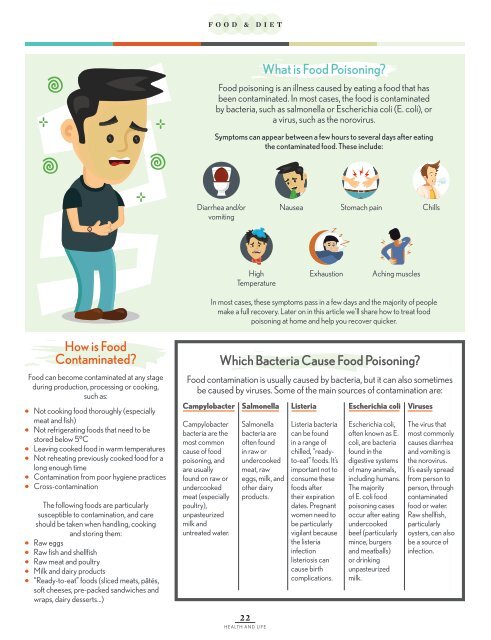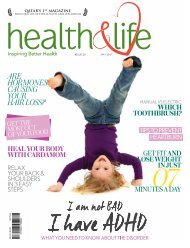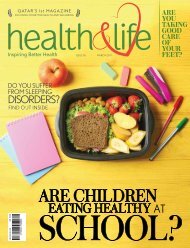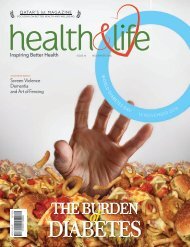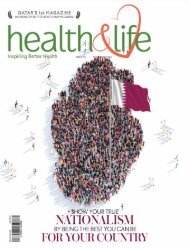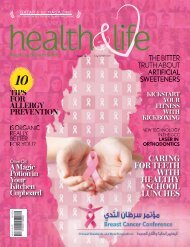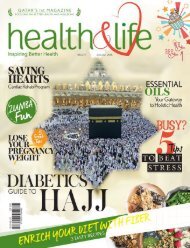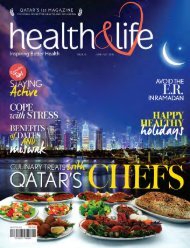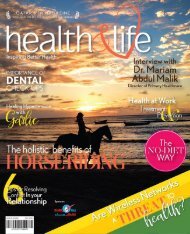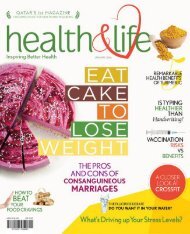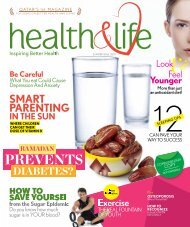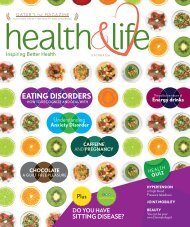Health & Life Magazine April 2017
Health & Life Magazine April 2017 www.health-n-life.com
Health & Life Magazine April 2017
www.health-n-life.com
You also want an ePaper? Increase the reach of your titles
YUMPU automatically turns print PDFs into web optimized ePapers that Google loves.
FOOD & DIET<br />
What is Food Poisoning?<br />
Food poisoning is an illness caused by eating a food that has<br />
been contaminated. In most cases, the food is contaminated<br />
by bacteria, such as salmonella or Escherichia coli (E. coli), or<br />
a virus, such as the norovirus.<br />
Symptoms can appear between a few hours to several days after eating<br />
the contaminated food. These include:<br />
Diarrhea and/or<br />
vomiting<br />
Nausea<br />
Stomach pain<br />
Chills<br />
High<br />
Temperature<br />
Exhaustion<br />
Aching muscles<br />
In most cases, these symptoms pass in a few days and the majority of people<br />
make a full recovery. Later on in this article we’ll share how to treat food<br />
poisoning at home and help you recover quicker.<br />
How is Food<br />
Contaminated?<br />
Food can become contaminated at any stage<br />
during production, processing or cooking,<br />
such as:<br />
Not cooking food thoroughly (especially<br />
meat and fish)<br />
Not refrigerating foods that need to be<br />
stored below 5°C<br />
Leaving cooked food in warm temperatures<br />
Not reheating previously cooked food for a<br />
long enough time<br />
Contamination from poor hygiene practices<br />
Cross-contamination<br />
The following foods are particularly<br />
susceptible to contamination, and care<br />
should be taken when handling, cooking<br />
and storing them:<br />
Raw eggs<br />
Raw fish and shellfish<br />
Raw meat and poultry<br />
Milk and dairy products<br />
“Ready-to-eat” foods (sliced meats, pâtés,<br />
soft cheeses, pre-packed sandwiches and<br />
wraps, dairy desserts…)<br />
Which Bacteria Cause Food Poisoning?<br />
Food contamination is usually caused by bacteria, but it can also sometimes<br />
be caused by viruses. Some of the main sources of contamination are:<br />
Campylobacter<br />
Campylobacter<br />
bacteria are the<br />
most common<br />
cause of food<br />
poisoning, and<br />
are usually<br />
found on raw or<br />
undercooked<br />
meat (especially<br />
poultry),<br />
unpasteurized<br />
milk and<br />
untreated water.<br />
Salmonella<br />
Salmonella<br />
bacteria are<br />
often found<br />
in raw or<br />
undercooked<br />
meat, raw<br />
eggs, milk, and<br />
other dairy<br />
products.<br />
Listeria<br />
Listeria bacteria<br />
can be found<br />
in a range of<br />
chilled, “readyto-eat”<br />
foods. It’s<br />
important not to<br />
consume these<br />
foods after<br />
their expiration<br />
dates. Pregnant<br />
women need to<br />
be particularly<br />
vigilant because<br />
the listeria<br />
infection<br />
listeriosis can<br />
cause birth<br />
complications.<br />
Escherichia coli<br />
Escherichia coli,<br />
often known as E.<br />
coli, are bacteria<br />
found in the<br />
digestive systems<br />
of many animals,<br />
including humans.<br />
The majority<br />
of E. coli food<br />
poisoning cases<br />
occur after eating<br />
undercooked<br />
beef (particularly<br />
mince, burgers<br />
and meatballs)<br />
or drinking<br />
unpasteurized<br />
milk.<br />
Viruses<br />
The virus that<br />
most commonly<br />
causes diarrhea<br />
and vomiting is<br />
the norovirus.<br />
It’s easily spread<br />
from person to<br />
person, through<br />
contaminated<br />
food or water.<br />
Raw shellfish,<br />
particularly<br />
oysters, can also<br />
be a source of<br />
infection.<br />
22<br />
HEALTH AND LIFE


